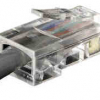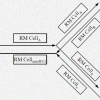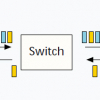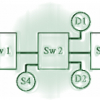113
click to vote
Publication
Congestion avoidance mechanisms allow a network to operate in the optimal region of low delay and high throughput, thereby, preventing the network from becoming congested. This is ...
Publication
We propose a scheme for congestion avoidance in networks using a connectionless protocol at the network layer. The scheme uses a minimal amount of feedback from the network to the ...
103
click to vote
Publication
Popular myths that cheaper memory, high-speed links and high-speed processors will solve the problem of congestion in computer networks are shown to be false. A simple definition f...
102
click to vote
Publication
Weaknesses in several recently proposed ideas about congestion control and avoidance in high-speed netwroks are identified. Both sides of the debate concerning prior reservation of...
Publication
Congestion control mechanisms for ATM networks as selected by the ATM Forum traffic management group are described. Reasons behind these selections are explained. In particular, se...
Publication
he Available Bit Rate (ABR) service has been developed to support data applications over Asynchronous Transfer Mode (ATM) networks. The network continuously monitors its traffic an...
Publication
The OSU scheme is a rate-based congestion avoidance scheme for ATM networks using explicit rate indication. This work was one of the first attempts to define explicit rate switch m...
Publication
The Asynchronous Transfer Mode (ATM) networks are quickly being adopted as backbones over various parts of the Internet. This paper analyzes the performance of TCP/IP protocols ove...
Publication
In this paper we study the design issues in improving TCP performance over the ATM UBR service. ATM-UBR switches respond to congestion by dropping cells when their buffers become f...
Publication
The Available Bit Rate (ABR) service in ATM networks has been specified to allow fair and efficient support of data applications over ATM utilizing capacity left over after servici...





